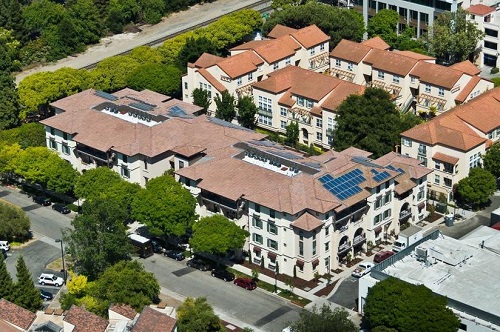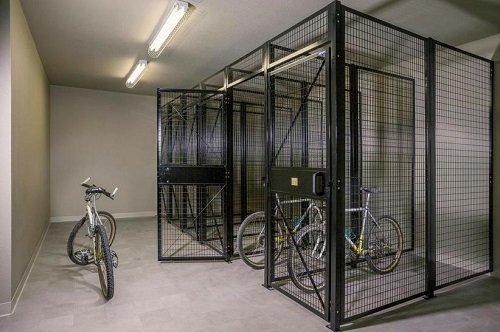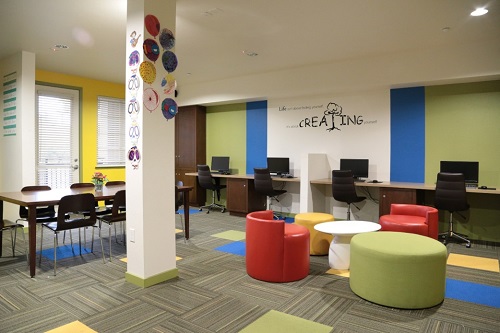
Public-Private Partnership Funds Affordable Housing near Transit

The scale and Mediterranean style of the Franklin Street Family Apartments helps the development blend into the surrounding neighborhood. Image courtesy of Steve Proehl of Proehl Studios. Located in California’s Silicon Valley and home to Google and many other high-tech businesses, the city of Mountain View, with a population estimated to be 76,600 in 2012, is experiencing a severe shortage of affordable housing. To address this shortage, ROEM Development Corporation, with support from the city, Google, and Citi Community Capital, opened Franklin Street Family Apartments in September 2013. The four-story development, located in downtown Mountain View near the city’s Caltrain station, provides 51 residential units affordable to households earning up to 50 percent of the area median income.
Affordable Housing Needs
May 2012 data from the U.S. Bureau of Labor Statistics indicate that the San Jose-Sunnyvale-Santa Clara metropolitan statistical area, where Mountain View is located, has a high concentration of employees in computer-related occupations. Although these workers earn over 50 percent more than the average employee in the region, their high incomes are matched by high housing costs. According to 2012 American Community Survey (ACS) data, most Mountain View households are renters and the city’s median rent of $1,650 is higher than that of both California and the nation as a whole.
ACS data from the U.S. Census Bureau and Consolidated Planning data from HUD indicate that the area’s high housing costs are a particular hardship for low-income households (table 1). Although only a small percentage of all renter households in Mountain View are cost burdened, the city has a larger percentage of low-income households who are cost burdened than does the nation, indicating a substantial need for affordable rental housing.
Table 1. Housing and Economic Data |
|||||||||||||||||
|
2012 American Community Survey 1-Year Estimates |
2010 HUD CHAS 5-Year Estimates1 |
|||||||||||||||
| Median Household Income |
Median Rent |
No. of Renter Occupied Units |
Percent of Total Occupied Units that are Renter Occupied |
No. of Cost Burdened 2 Renter Households |
Total No. of Renter Households |
Percent of Renter Households who are Cost Burdened |
No. of Cost Burdened Low -Income3 Renter Households |
Total No. of Low-Income Renter Households |
Percent of Low- Income Renter Households who are Cost Burdened |
|||||||
|---|---|---|---|---|---|---|---|---|---|---|---|---|---|---|---|---|---|
| Mountain View | $91,422 | $1,650 | 20,678 | 64% | 6,200 | 18,120 | 34% | 5,020 | 6,870 | 73% | |||||||
| California | 58,328 | 1,200 | 5,770,841 | 46 | 2,661,315 | 5,280,800 | 50 | 2,381,695 | 3,272,620 | 73 | |||||||
| United States | 51,371 | 884 | 41,850,284 | 36 | 17,303,590 | 38,484,635 | 45 | 16,047,330 | 24,487,770 | 66 | |||||||
1. Comprehensive Housing Affordability Strategy custom tabulations from the U.S. Census Bureau’s 2006-2010 American Community Survey housed in HUD’s CHAS data sets.
2. Cost-burdened households pay more than 30 percent of income for housing costs.
3. Low-income households earn up to 80 percent of HUD area median family income.
More than Lowering Housing Costs

To encourage residents to use bicycles, Franklin Street Family Apartments includes a bike cage for each unit. Image courtesy of Jim Doyle of Applied Photography.
To accommodate households with children, most of the 51 units in Franklin Street Family Apartments contain more than one bedroom; the development has 32 two-bedroom units (including a manger’s unit) and 15 three-bedroom units but only 4 one-bedroom units. A landscaped courtyard with play equipment provides outdoor space next to the Mediterranean-style building. The city and ROEM involved the public through several focus groups and neighborhood meetings during the project’s design. In response to public input, a large oak tree was preserved, the ramp to the underground parking facility relocated, and the building’s height made consistent with neighboring condominiums.
The building has several features to promote sustainability and keep costs low for residents and building management. The apartments include high-efficiency fluorescent lighting, ENERGY STAR® appliances, and insulated windows with low-E glass. The building also has low-flow plumbing, energy-efficient heating and cooling systems, and solar photovoltaic panels. In addition, the site features vegetated swales to treat stormwater and drought-tolerant landscaping, and 78 percent of the project’s construction waste was recycled. The apartments exceed the energy-efficiency standards of Title 24, the state building standards code, by 22.2 percent.
The development also gives residents access to low-cost transportation and amenities. The development is within a half-mile of a Caltrain station, which connects to local light rail and shuttles, as well as to a commuter rail system that serves destinations between San Francisco and San Jose. ROEM provided Eco Pass transit passes to residents to promote the use of public transportation, and each unit includes access to a bike cage to encourage residents to use bicycles. Residents also benefit from the development’s downtown location; according to Linda Lauzze, Mountain View’s neighborhood services manager, “the successful downtown stores and restaurants . . . provide residents with ongoing job opportunities and services within easy walking distance.”
Residents of the Franklin Street Family Apartments have access to an onsite library, fitness room, community room, tot lot, and barbeque area. Residents can also take advantage of many free onsite services provided by Pacific Housing, Inc., including computer, English as a second language, and afterschool homework assistance as well as yoga classes.
City and Investors Support Franklin Street Family Apartments
Recognizing the need for affordable housing, the city used several programs to financially support the affordable housing development. Mountain View provided ROEM with a $3.2 million loan for a long-term ground lease for the property (65 years with an option to renew for another 20 years) and a $12.5 million loan toward the project’s $23.8 million development costs. Sources of this funding were the city’s allocation under HUD’s Community Development Block Grant program, housing set-aside funds from the Downtown Revitalization District’s tax increment revenues, and fees from developers who opted not to create affordable units under the city’s Below Market Rate Housing Ordinance.
Google provided approximately $6.3 million in LIHTC equity for the project through syndicator AEGON USA Realty Advisors in addition to $82,000 for computer equipment and free Internet access for residents. Citi Community Capital, which had worked with ROEM on 15 consecutive developments, contributed another $4.2 million in LIHTC equity.
Meeting Needs and Fulfilling Goals

The Franklin Street Family Apartments offer services like homework help for children; residents also have access to computer equipment and the internet funded by Google. Image courtesy of Jim Doyle of Applied Photography.According to Erin Caputo, marketing manager for ROEM, “Franklin Street Family Apartments could not have happened without partnerships between the City of Mountain View, ROEM Corporation, its financial partners and other public and private parties who helped fund the development and implement onsite amenities and services that directly benefit the residents.” Residents will benefit from the Franklin Street Family Apartment’s affordable units, sustainable features, and accessible location, which will help keep housing, utility, and transportation costs low and reduce housing costs in an expensive area. Caputo also states that the development “serves as a positive force on the family: shorter commutes, better schools, many opportunities often only afforded to those in higher income brackets.” Both reaffirming the success of the project and demonstrating the continued need for affordable housing, the development was fully leased before opening, and more than 170 Mountain View households are currently on its waiting list.
PD&R Leadership Message Archive
International & Philanthropic Spotlight Archive
Spotlight on PD&R Data Archive
Publications
Collecting, Analyzing, and Publicizing Data on Housing Turnover
Resilience Planning: What Communities Can Do to Keep Hazards from Turning into Disasters
Cityscape: Volume 26, Number 3
Case Studies
Case Study: Former School in Charleston, South Carolina, Transformed into Affordable Housing for Seniors
Case Study: Avalon Villas Combines Affordable Housing and Services for Families in a Gentrifying Phoenix Neighborhood

The contents of this article are the views of the author(s) and do not necessarily reflect the views or policies of the U.S. Department of Housing and Urban Development or the U.S. Government.
Note: Guidance documents, except when based on statutory or regulatory authority or law, do not have the force and effect of law and are not meant to bind the public in any way. Guidance documents are intended only to provide clarity to the public regarding existing requirements under the law or agency policies.



